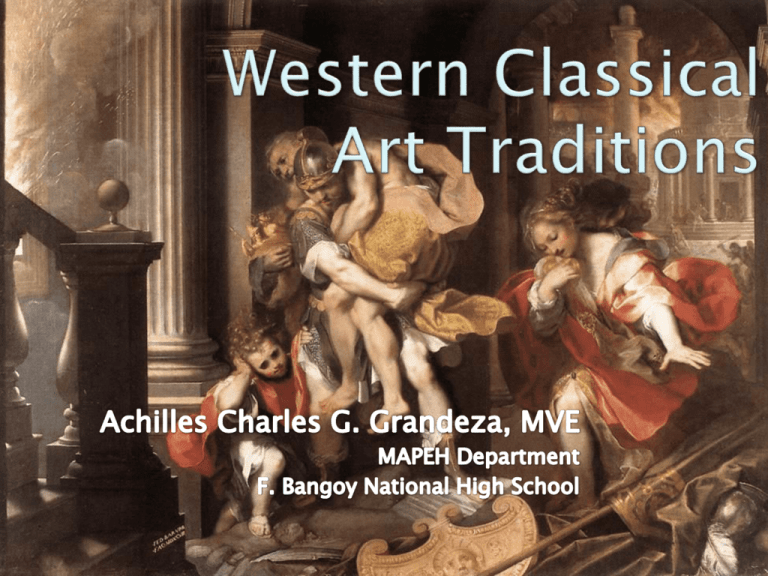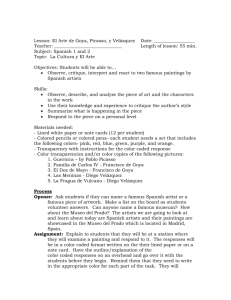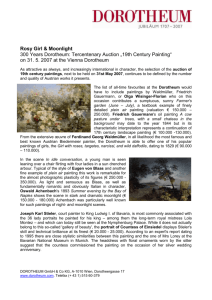Western Classical Art Traditions
advertisement

Above 11 means HIMANTAYUN KANG DAKO! 10-11 Extraordinarily observant 8-9 Very Observant 6-7 means above average 4-5 faces means an average rate in observation and attention to detail In this lesson, you will learn about the different characteristics, functions and types of art forms (painting, sculpture, architecture) from Pre-Historic (including ancient Egyptian art forms), Classical (Greek and Roman) up to Medieval era (Baroque and Romanesque art forms.) Try to analyze each art form and discover how they develop in every period. Pre-historic includes all human existence before the emergence of writing. Their art is of interest not only to the art historians but also to archeologist and anthropologist, for whom the art is only one clue- along with fossils, pollens and other finds to an understanding of early human life and culture. Their paintings were found inside the caves which may have been their way of communicating with each other. It may also be for religious or ceremonial purposes. These paintings may be more an artifact of the archeological evidence than a true picture of humans’ first created art. Prehistoric drawings of animals were usually correct in proportion. The dominant features in the painting were large animals native in the region. It was discovered on 12 September 1940 and given statutory historic monument protection. The painting has nearly 2,000 figures composed mainly of animals, human figures and abstract design. Some sections have been identified inside the cave such as: The Great Hall of the Bulls, The Lateral Passage, The Shaft of the Dead man, The Chamber of Engravings, The Painted Gallery, and the Chamber of Felines The purpose of Egyptian paintings is to make the deceased afterlife place pleasant. With this in mind, themes include journey to the underworld introducing the deceased to the gods of the underworld by their protective deities. It emphasizes the importance of life after death and the preservation of the knowledge of the past. Most paintings were highly stylize, symbolic, and shows profile view of an animal or a person. The main colors used were red, black, blue , gold and green taken derived from mineral pigments that can withstand strong sunlight without fading. Paintings during the classical era were most commonly found in vases, panels and tomb. It depicts natural figures with dynamic compositions. Most of the subjects were battle scenes, mythological figures, and everyday scenes It reveals a grasp of linear perspective and naturalist representation. Fresco- method of painting waterbased pigments on a freshly applied plaster usually on a wall surfaces. Colors are made with grind powder pigments in pure water, dry and set with a plaster to become a permanent part of the wall. Ideal for murals, durable and has a matte style. Encaustic – developed to use by Greek ship builders, who used the hot wax to fill the cracks of the ship. Soon pigments (colors) was added and used to paint a wax hull. Kerch Style also referred to as Kerch Vases are red-figured pottery named after the place where it was found. pelike (wine container) lekanis (a low bowl with two horizontal handles and a low broad foot) lebes gamikos (with high handles and lid use to carry bridal bath) krater (bowl use for mixing wine and water) There are paintings on flat panels of wood. It can be either a small, single piece or several panels joined together. Most of the panel paintings no longer exist because of its organic composition. The earliest known panel painting is the: Tomb or wall painting was very popular during the classical period. It uses the method frescos either tempera (water-base) or encaustic (wax). It has a sharp, flatly outlined style of painting and because it uses water-based materials, very few samples survived. The image was painted using a true fresco technique with a limestone mortar. It depicts a symposium scene on the wall. Most of the paintings in this era were copied or imitated from Hellenic Greek paintings. Fresco technique was used in brightly colored backgrounds; division of the wall into a multiple rectangular areas (tic-tac-toe design); multi-point perspective; and a tropme-l’-oeil effect. a style of painting in which objects are depicted with photographically realistic detail; also : the use of similar technique in interior decorating Roman paintings have a wide variety of subjects, animals, everyday life, still life, mythological subjects, portraits and landscapes. The development of landscape painting is the main innovation of Roman painting from Greek painting. It is an art process where an image is created using an assemblage of small pieces of colored glass, stones, or other materials. This technique is used for decorative art or interior decorations. The full image is a Roman floor mosaic in the House of Fun Pompei, dated 100 B.C. The whole mosaic depicts the battle between the armies of Alexander the Great and Darius III of Persia. This fresco painting was believed to depict ceremonial rites, either marriage or an initiation of a woman in a mystery cult. The lively styles of paintings which had been invented in Greek and Rome lived on in Byzantium but this time for Christian subjects. By the 11th century, the Greek and Oriental styles seem to blend together in magnificent, imposing images, which adorned the churches in large and small forms. These are largely placed mosaics on the walls of the churches that follows a strict frontal pose. It has a remarkable variety of artistic traditions such as modeling and treatment of faces and draperies that follow Byzantine convention while the refreshingly decorative feeling comes from southern French styles. It also shows traces of Mozarabic influence (Arabize influence) through elongated oval faces, large staring eyes and long noses, figures against flat colored bands and heavy outlining. Christ wears a greyish, white robe with a blue mantle. Underneath the Mandorla (Italian word for Almond, in painting, it is used to described an enclosure surrounding holy figures) is a black band with white writing. Each side of the center window are three arches resting on columns of capitals in green, red and black in between of figures of Virgin Mary and five saints are columns with wavy line patterns going vertically. Paintings have been confined in the illumination of manuscript pages and the painting of frescoes on the walls of churches in cosmopolitan style, elegant, mannered and sophisticated. Subjects usually depicts popular legends and love stories, patterns like “mille fleur” or thousand flowers show influence which may have been due to the Crusades.







